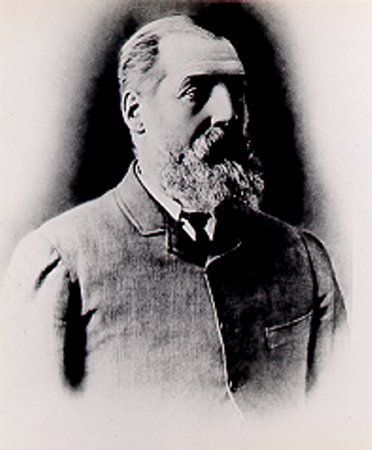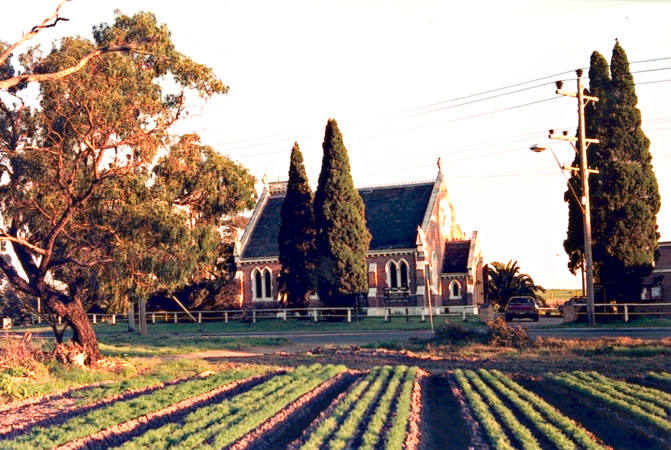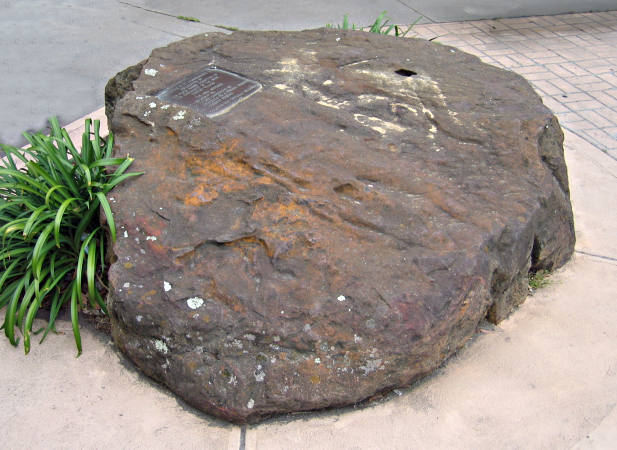What’s in a Name?

Members of the Melbourne Hunt Club in front of Christ Church, Anglican Church of Dingley, c1920. Courtesy Dorothy Allnutt.
What’s in a name? A question that has been asked many times. Some residents of Dingley thought it important enough to seek official approval for a name change for their suburb assigned the postal address of 3172.
The name Dingley is believed to have originated with two early settlers in the district. Thomas Attenborough and his sister Mary arrived in the Port Phillip colony on board the Roxburgh Castle in July 1853. Within three years they purchased 170 acres of bushland from Patrick Riley for £280. [1]. There they build a home, erected fences, grew vegetables and stocked the property with cattle and sheep. They named their house “Dingley Grange” referring back to “Dingley” their place of origin in the county of Northamptonshire, in the United Kingdom.

Thomas Attenborough, Dingley Pioneer. Courtesy Kingston Collection.
Thomas and Mary were great benefactors to the district taking a prominent and active role in community affairs. Through their efforts a school was established and a church was built. On her death in 1876 Mary left the proceeds of her property to the Church of England in Victoria and to Christ Church, the church she had built on the corner of Centre Dandenong Road and Old Dandenong Road. Later Thomas was to return to England for a holiday and met Mary Jane Stokes whom he married. Three years after his return to Dingley he sold his property and moved with his wife to a residence in Cheltenham. The sale of the property was advertised in the Brighton Southern Cross on November 7, 1885 as thirty-nine blocks in the Dingley Grange Estate.

Christ Church, Anglican Church, Dingley, c1970. Courtesy Jean Mitchell.
The community remained small in terms of numbers for many years with market gardening being the prime occupation. By the 1900s school records show that market gardening was still the most common occupation of parents, individuals in the professional were rare, but the occupations of dairyman, grocer, grazier and orchardist now appear. Even by 1953 market gardening continued to be the most frequently listed occupation although there was a much wider range of occupations noted, including company manager, traveller, nurseryman, motor mechanics, electrician, welder, and florist. By the 1970s the range of occupations was much broader without any one occupation dominating the list. [2]
A Progress Association was formed in the 1940s with the objective of promoting the cause of getting some public buildings erected in Dingley but it went into abeyance and was not revitalized until 1971 when the Dingley Village Community Association was formed to tackle community issues such as rates, roads, and rubbish. For a time, the Association met fairly regularly to discuss topical issues, but by 1982 had faded from view. It was in 1987 that the arrival of a bank statement alerted Marion Harriden to the fact that a small amount of money was held by the bank in the name of the Progress Association. “What was to be done with this money?” This was the question asked.
Marion Harriden as the Manager of the Dingley Village Neighbourhood Centre called a meeting of people who had been association with the Progress Association and put the question about the money to them. They resolved to pass the small amount of money to the Neighbourhood Centre but other question was raised. Was there a need for a community association? If it was felt there was such a need what should such an association be doing? Ideas were discussed and shared in informal social gatherings over cups of coffee until it was finally resolved that an association was needed to promote the town and agitate for improvements to facilities.
In 1989 a committee was formed with the name Lets Put the Village Back into Dingley with a major project being the gaining of official approval to rename Dingley as Dingley Village. [3] Gaining support of the Springvale Council an application was made to the Place Names Committee, a State instrumentality, for the change. [4] Mr Ryan, the Acting Chief Executive Officer, in his letter pointed out that the area had been known to local residents as Dingley Village for a number of years and the local community centre bore that name.
The secretary of the Place Names Committee responded to the Springvale request for a name change asking for evidence of community support for such a change. He also warned the Council that the committee had reservations about the request doubting that Dingley had the characteristics of a village in either appearance, atmosphere, environment or size. [5]
The Lets Put the Village Back into Dingley proceeded to gather the evidence of support for its proposal. A notice was placed in the Dingley Dossier [6] asking residents to sign the petition which was available in the shopping centre and at the Neighbourhood Centre. A State Parliament election was about to take place. On the day of the election members of the Lets Put the Village Back into Dingley placed themselves outside the polling booths at the local primary schools and urged the voters to sign the petition. This they did in considerable numbers, standing in line and asking where to sign!
What was the motivation behind this support? Marion Harriden suggested that at the time there was a strong association with Britain with many residents tracing back their ancestry to that country. She recalled as an illustration the fact that the local Dingley cricket team on winning a premiership went to England as a reward and while there played an English Dingley team. As only sixty people lived in the country village individuals from beyond the village had to be enlisted. The event was a great success and was reported in our local papers generating considerable interest in the ‘home country’. Another suggested reason for the addition of the word ‘village’ was the desire of individuals to create the idea that living in Dingley was different, something special and exclusive. Estate agents adopted the suggestion with gusto perhaps seeing the possibility of it increasing property values and sales.
Marion Harriden as secretary of the Let’s Put the Village Back into Dingley committee wrote to the secretary of the Place Names Committee providing the evidence of support given by 482 individuals who had signed the petition for the change of name. In addition, she said, while many suburbs claim to have a village atmosphere that defines local character and unites residents but in reality they are merely separated from surrounding suburbs by roads, or topography. Dingley she suggested was not like that. Dingley she pointed out was surrounded by four golf courses, Moorabbin, Kingswood, Spring Park and Southern and Braeside Park, it was truly a village. She included a map with her letter to support her claim.
The Place Name Committee accepted the evidence and arguments submitted to it and informed the Dingley committee of its intention to publish in the Government Gazette a “Notice of Proposal” to change the name. After a period of two months, during which time objections could be submitted, the Place Names Committee would make a decision. [7] On August 26, 1991, the government committee wrote confirming the name change as no objections had been received and a notice was published in the Government Gazette, August 7, 1991.
A weekend of celebrations was organised to mark the success, a “Goodbye Dingley, hello Dingley Village.” The Mayor of Springvale, Cr Joan Sheen, unveiled a plaque commemorating the renaming of the village with more than two hundred people witnessing the event at the Dingley Village Neighbourhood Centre. Community groups taking part included Scouts, Lions, Kiwanis, the Senior Citizens’ Club, Red Cross and the Country Women’s Association which provided Devonshire teas. On the Saturday night a family supper dance was held with music provided by Russ and Rhonda Hesketh. [8] A plaque was also mounted on a Dingley Rock in the Centre Dandenong Road shopping area. The rock was excavated from a quarry that was on the site of Din San Nursery and was donated by the nursery owner, Ern Smith.

Plaque on a Dingley Rock in Pethybridge Place, Dingley Village, 2006. Plaque reads “To commemorate the Declaration by the Place Names Committee of the Assignment of the name Dingley Village. The area assigned: West – Boundary Rd., South - Lower Dandenong Rd., East – Springvale Rd., and Freeway Reserve, North – Freeway Reserve. This occasion was officially recognised on 7–8–91". Courtesy Kingston Collection.
At the end of 1991 the Let’s Put the Village Back into Dingley committee changed its name as they agreed they had achieved that goal. [9] They became the Dingley Village Community Association with an immediate ambition of implementing the Dingley Village concept. This included gateway signs, streetscape work, and a western entrance with a clock tower. One ongoing task was to encourage individuals and organisations to adopt the official name of the location in correspondence and signage. As Marion Harriden pointed out in her letter from the Dingley Village Neighbourhood Centre “the official name change does not mean much, unless our residents, our schools, our sporting bodies, our community groups, our churches, and our traders, are making a conscious effort to use the name.” The campaign continued as some organisations saw their history linked to the name Dingley and were reluctant to surrender it. The Springvale Council changed all its records to read “Dingley Village”. Others persisted for some time. In September 1995 the editor of the Village News was asked to draw the attention of his readers to the fact that they live in Dingley Village and not Dingley. The authorities at Local and State Government level know that you live in Dingley Village, do you? [10]
The name Dingley Village is now firmly entrenched in the community with most people giving it little thought. Nevertheless there are some traffic signs that still have to be changed to conform to the official wording and some organisations with a long history associated with the name Dingley have been slow to adopted the new nomenclature. Perhaps with the passage of time the name Dingley Village will be universally accepted.
